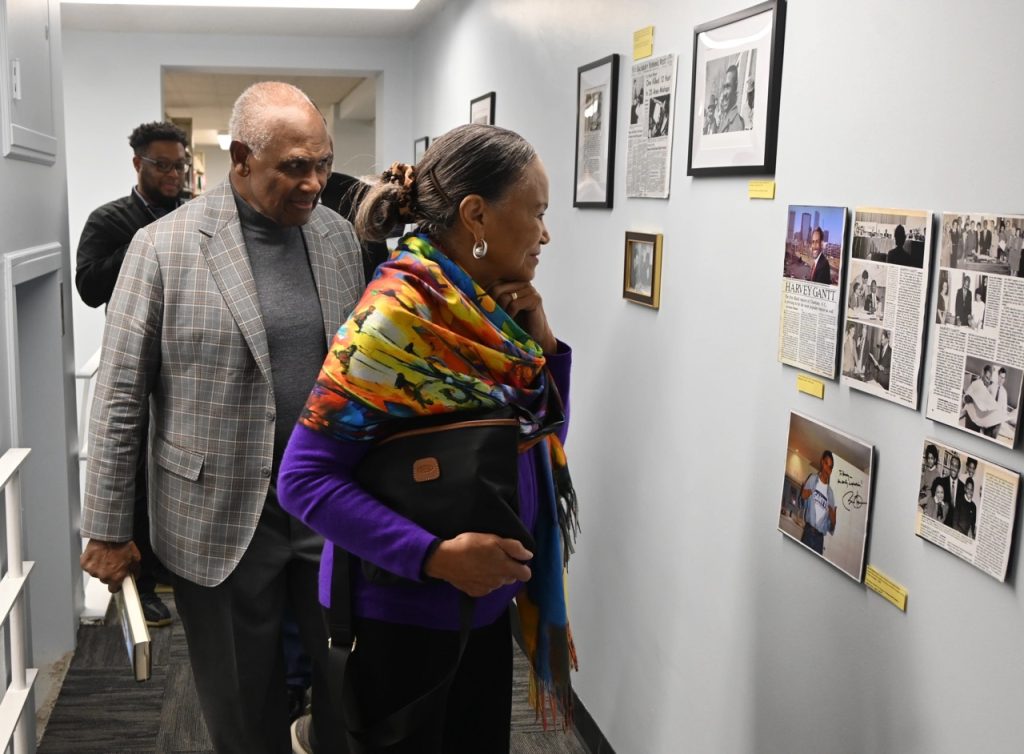SALISBURY — Harvey Gantt has been a beacon of hope for many people who have aspired to do more with their lives despite their circumstances. As an architect, politician and public figure, Gantt has never slowed down in his pursuit of making a difference.
On Feb. 1, Gantt spoke at the welcome reception for the “We Built This: Profiles of Black Architects and Builders in North Carolina” traveling exhibit that has relocated to Livingstone College to coincide with Black History Month.
The exhibit was partly sponsored by the Historic Salisbury Foundation so that they could continue to bring to light the figures that have laid the groundwork of where we are today.
“For 52 years, Historic Salisbury Foundation has had a mission to preserve and protect the historic fabric of Salisbury and Rowan County and a lot of that has to do with saving buildings. Another part of that is partnering with the community and a great example of that is tonight,” HSF Executive Director Kimberly Stieg said.
Livingstone President Dr. Anthony Davis introduced Gantt at the reception and praised him for the impact he has made not just in the Carolinas, but the entire country. “He inspired not a generation, but generations,” Davis said. “Sometimes standing up for what’s right means having the courage to blaze your own trail.”
 In 1963, Gantt became the first Black student enrolled at Clemson University. After he graduated, he obtained his master’s from MIT and then founded Gantt Huberman Architects with Jeff Huberman in 1971. He was then elected as Charlotte’s first Black mayor in 1983.
In 1963, Gantt became the first Black student enrolled at Clemson University. After he graduated, he obtained his master’s from MIT and then founded Gantt Huberman Architects with Jeff Huberman in 1971. He was then elected as Charlotte’s first Black mayor in 1983.
“When I got to school, a lot of people thought I should have the burden of the entire African American race on my shoulders and it didn’t quite feel that way. It always felt that the promise of America was going to be made real by pursuing education, vigor, energy and preparation. I was always confident that I could make it through and do well,” Gantt said.
When it came to architecture, Gantt mentioned the educators and guidance counselors that pushed him towards his lifelong profession. While only 2 percent of architects in America are Black, that fact motivated Gantt even more.
“It felt very natural doing it. For me, it was an artform that made a lot of sense,” Gantt said.
Gantt and Huberman’s firm started with just the two of them, but it grew exponentially over time. They had no desire to be like the other architecture firms they competed with, they aimed to represent the true social fabric of where they lived. “We wanted the firm to look like America,” Gantt said.
“Sometimes when you want diversity, you have to be intentional about it. You have to go out and work for that diversity, you can’t expect that diversity and sympathy to walk in.” Gantt Huberman Architects designed several public and private projects that included the Charlotte Transportation Center, churches, libraries and buildings at Johnson C. Smith University.
“We wanted to create meaningful places, places that people would remember. We didn’t want to do anything what we call ‘cookie cutter.’ We wanted spaces that were creative and that were memorable,” Gantt said. “When I look back over our legacy and remember what our goals were when we started that firm years ago with a couple people, we succeeded.”
Once Gantt finished his speech, Mayor Karen Alexander, herself an architect who previously worked with Gantt at his firm, shared how much he shaped her to go out and thrive on her own.
“I feel so grateful to you all these years later because you put my life on a certain path that I didn’t believe at the time, that I could have my own firm,” Alexander said.
People then made their way over to the “We Built This” exhibit next door to take in an unsung aspect of history. Gantt said he already saw the exhibit last year in Charlotte, but he still relishes its significance. “I’m glad to see it on an HBCU campus,” Gantt said. “If you think about the percentage of architects in America that are Black, this is very special that they’re doing this and showing this here in the deep South in a wonderful place like this.”
